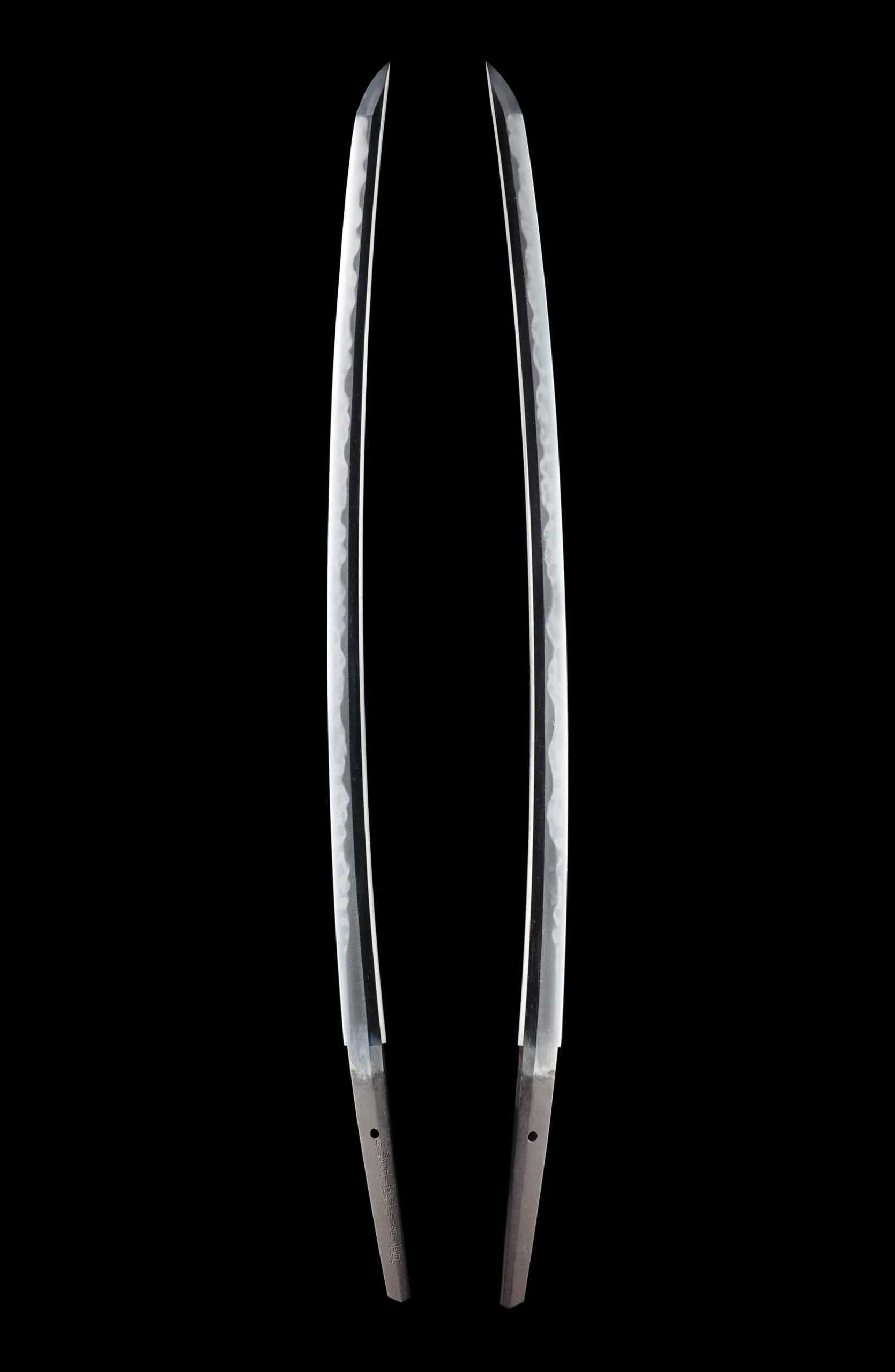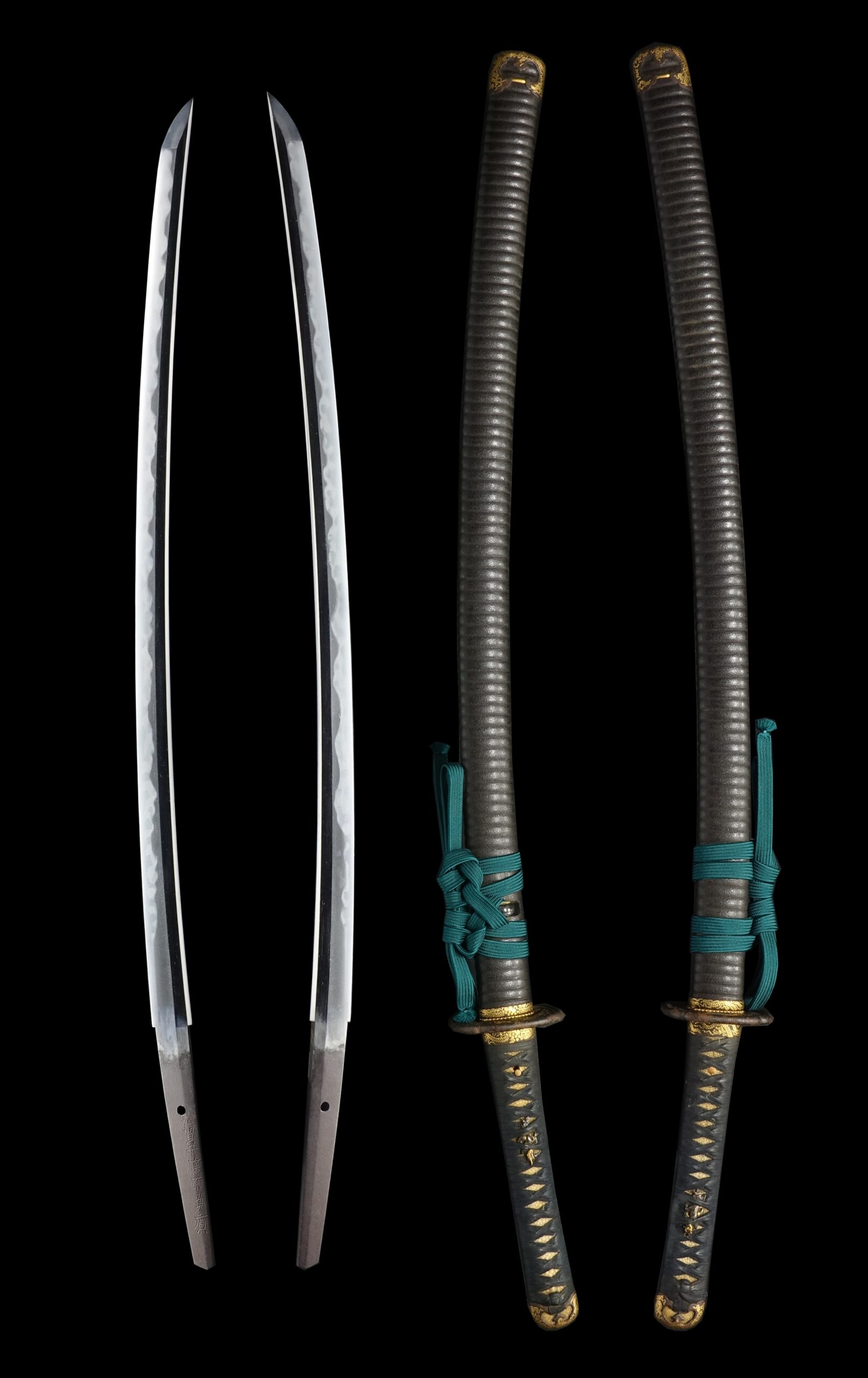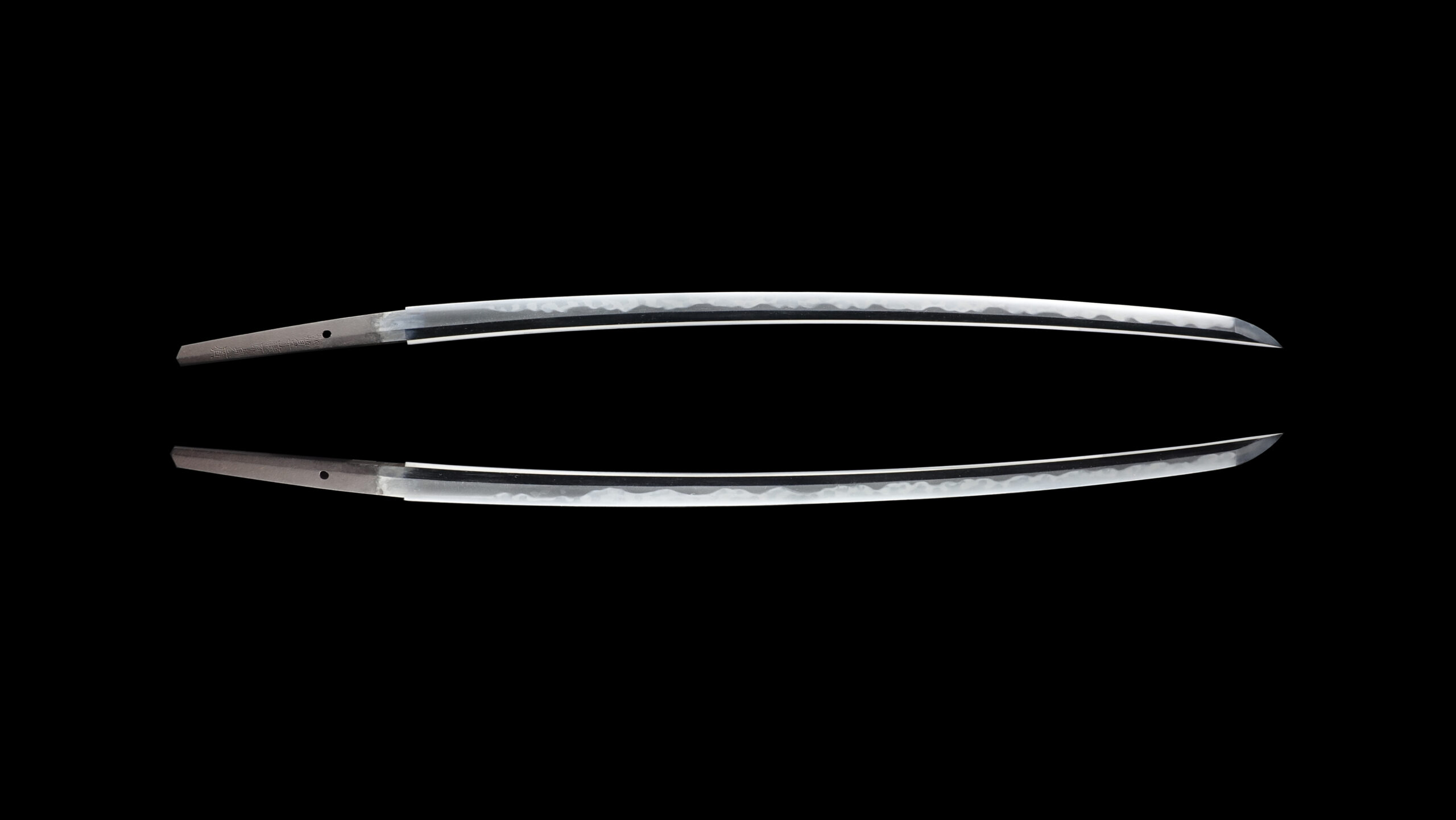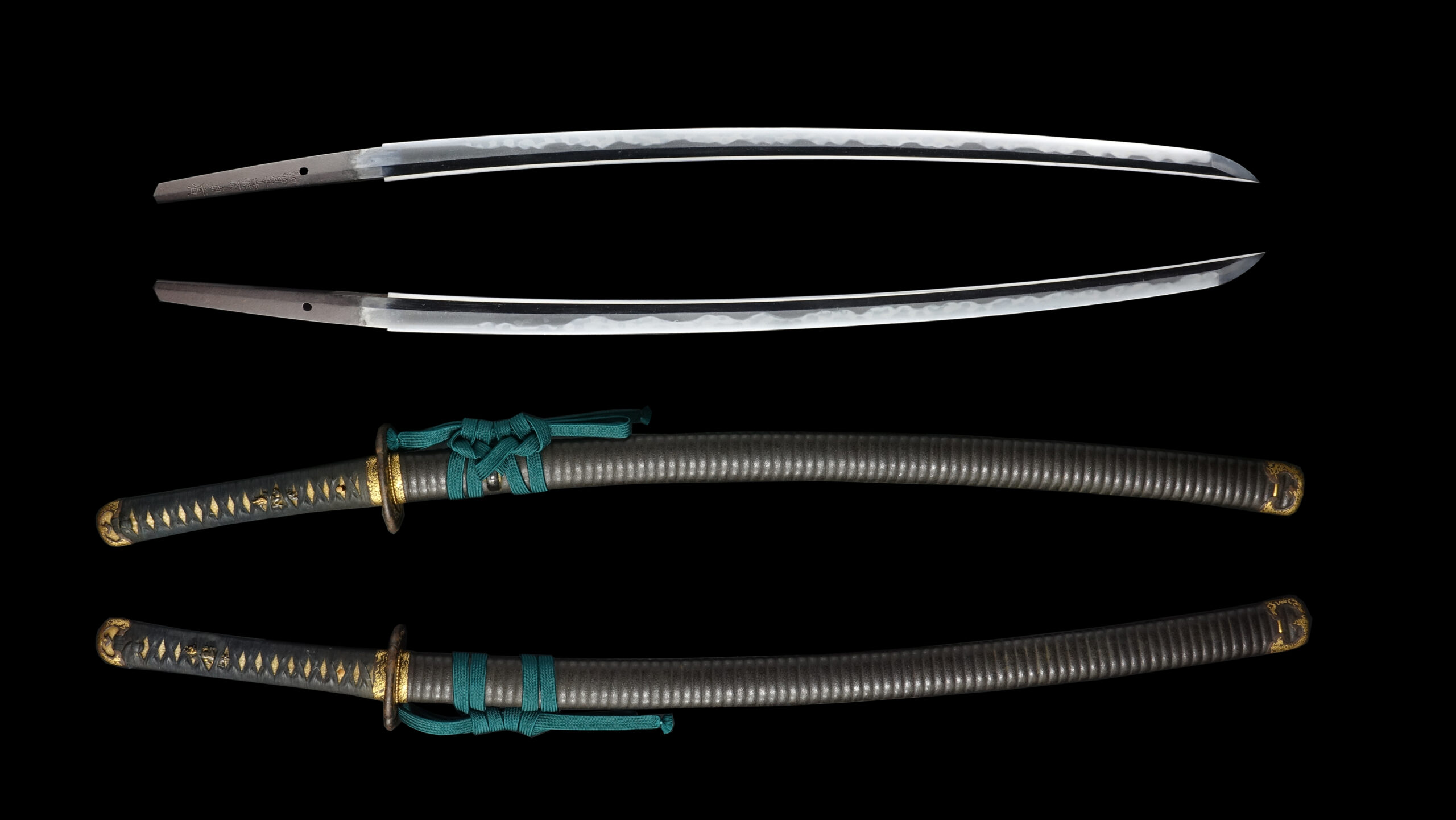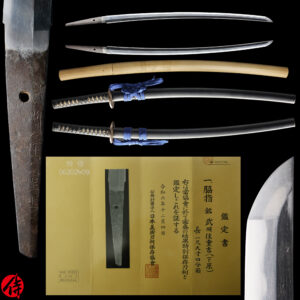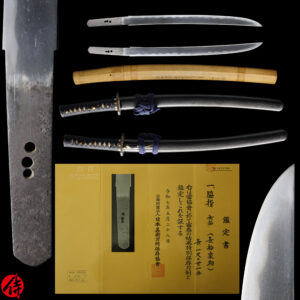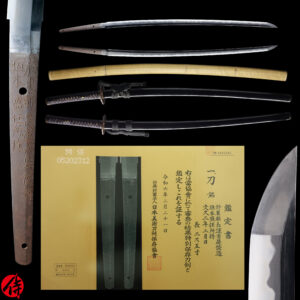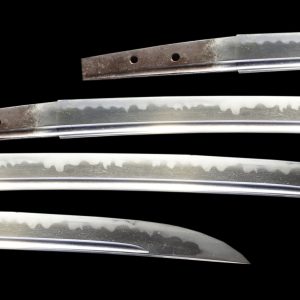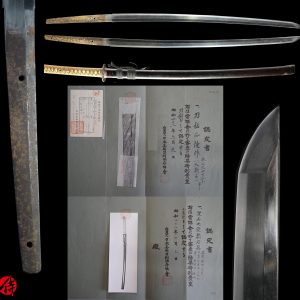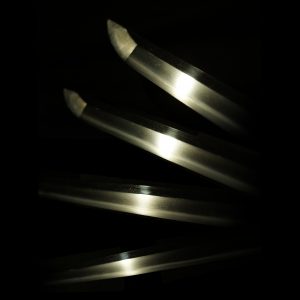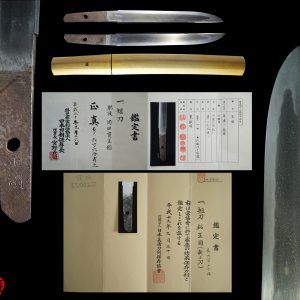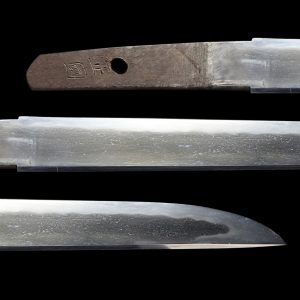Antique Japanese Sword Katana Signed by Sadahiro with Tokubetsu Hozon Certificate
【Description】
This blade was signed by Kaga no Kami Fujiwara Sadahiro(加賀守藤原貞広), who was born in 1640 in Echizen Shimosaka(today’s Fukui prefecture) and forged swords in the middle of the Edo period, specifically the Genroku Era(1688-1704).
Sadahiro belonged to Shimosaka school, initially founded in Shimosaka town in Shiga prefecture at the end of the Muromachi period. And the school moved to Echizen city(Fukui prefecture) at the beginning of the Edo period. Sadahiro engraved the title “(Kaga no Kami),” and his maker’s name “藤原貞廣(Fujiwara Tsuguhiro)” on the front. There was also a record where Sadahiro forged swords in Settsu province(Osaka prefecture) after leaving Echizen province.
About Echizen Shimosaka School
It is said that the first-gen Yasutsugu was the founder of the Echizen Shimoasaka school. He was born in Shimosaka town in Shiga prefecture at the end of the Muromachi period(Late 16 century ). He built his career there until the beginning of the Keicho era(1596). However, he moved to Echizen province due to the relocation of the lord he served. He eventually was noticed and supported by Matsudaira Hideyasu, the third son of Tokugawa Ieyasu, who was the founder of the Edo government. Hideysu was the feudal lord of Echizen province during the early Edo period. With the support of Hideyasu, the first-gen Yasutsugu was able to establish the Echizen Shimosaka school. And his school’s fame became nationwide.
By Hideyasu’s recommendation, the first-gen Yasutsugu became Okakaekaji for the Tokugawa shogun family, meaning that he exclusively forged swords for the Shogun family. Yasutsu was acknowledged by the first and second Tokugawa Shoguns, Tokugawa Ieyasu, and Tokugawa Hidetada.
The first-gen Yasutsugu received 康(YASU) from Tokugawa Ieyasu and changed his maker’s name. He was also allowed to inscribe the holly oak symbol(family crest of Tokugawa) on the tang. The school flourished during the Edo period and trained many skilled apprentices. The first-gen Sadatsugu is one of the most famous apprentices among many swordsmiths who resided in Echizen province.
About Echizen province
Echizen Province was famous for forging razor-sharp, practically designed swords. The Edo government, run by the Tokugawa clan, ordered many blades from the swordsmiths in this province during the Edo period(1603-1868). There were so many swordsmiths in Echizen province, originally from the Mino province(Gifu prefecture), which is known as one of the five great Japanese sword styles MINO-DEN.
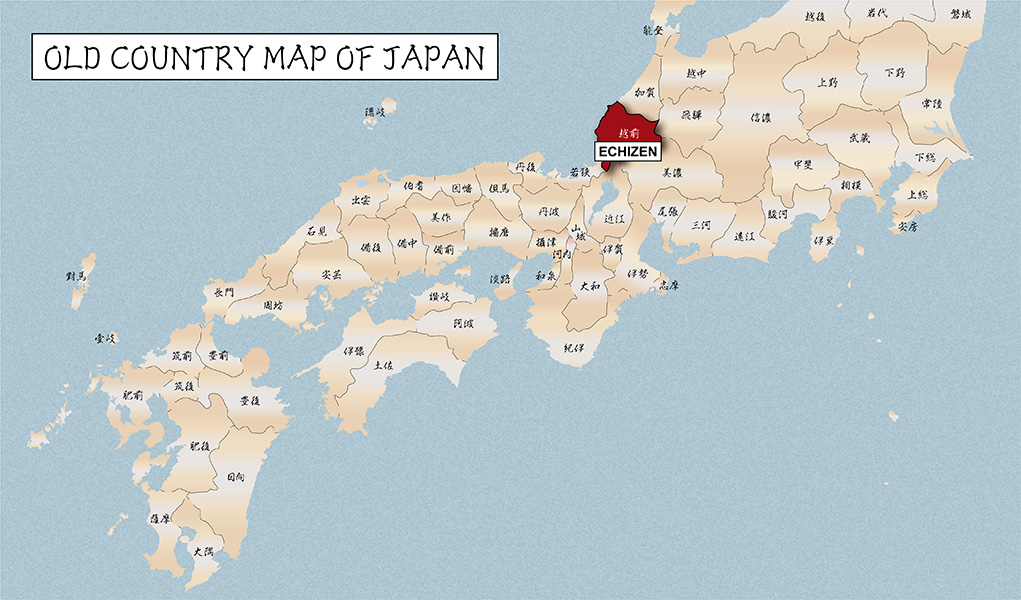
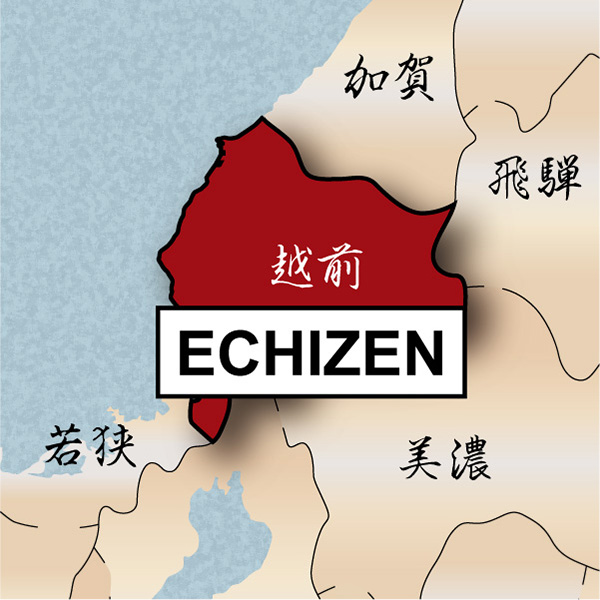
It is appraised as a Tokubetsu Hozon Token (特別保存刀剣) issued by NBTHK (Nihon Bijutsu Touken Hozon Kyokai:日本美術刀剣保存協会). This authentication paper was only given to authentic Japanese swords, especially well preserved and high quality with artistic value.
*Please keep in mind that there are a couple of Kitae Kizu on this blade. If you like to know the detailed condition, please feel free to contact us.
【Blade】
Cutting Edge Length(Nagasa):68.5 cm ( 28.1 inches)
Curvature(Sori):2.0 cm (0.62 inches)

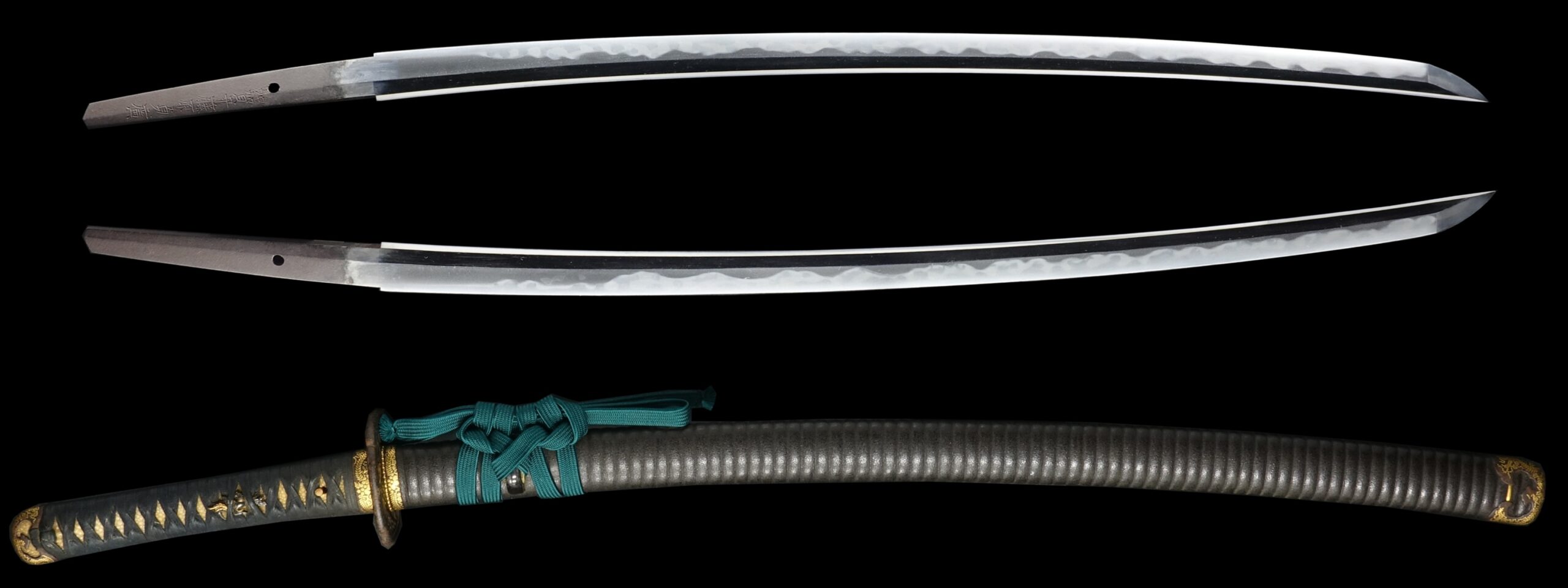
Hamon:
The crystalline structure which forms along the cutting edge of a blade as a result of the hardening process
Jimon(Jihada):
visible steel surface pattern created by folding and hammering during forging process
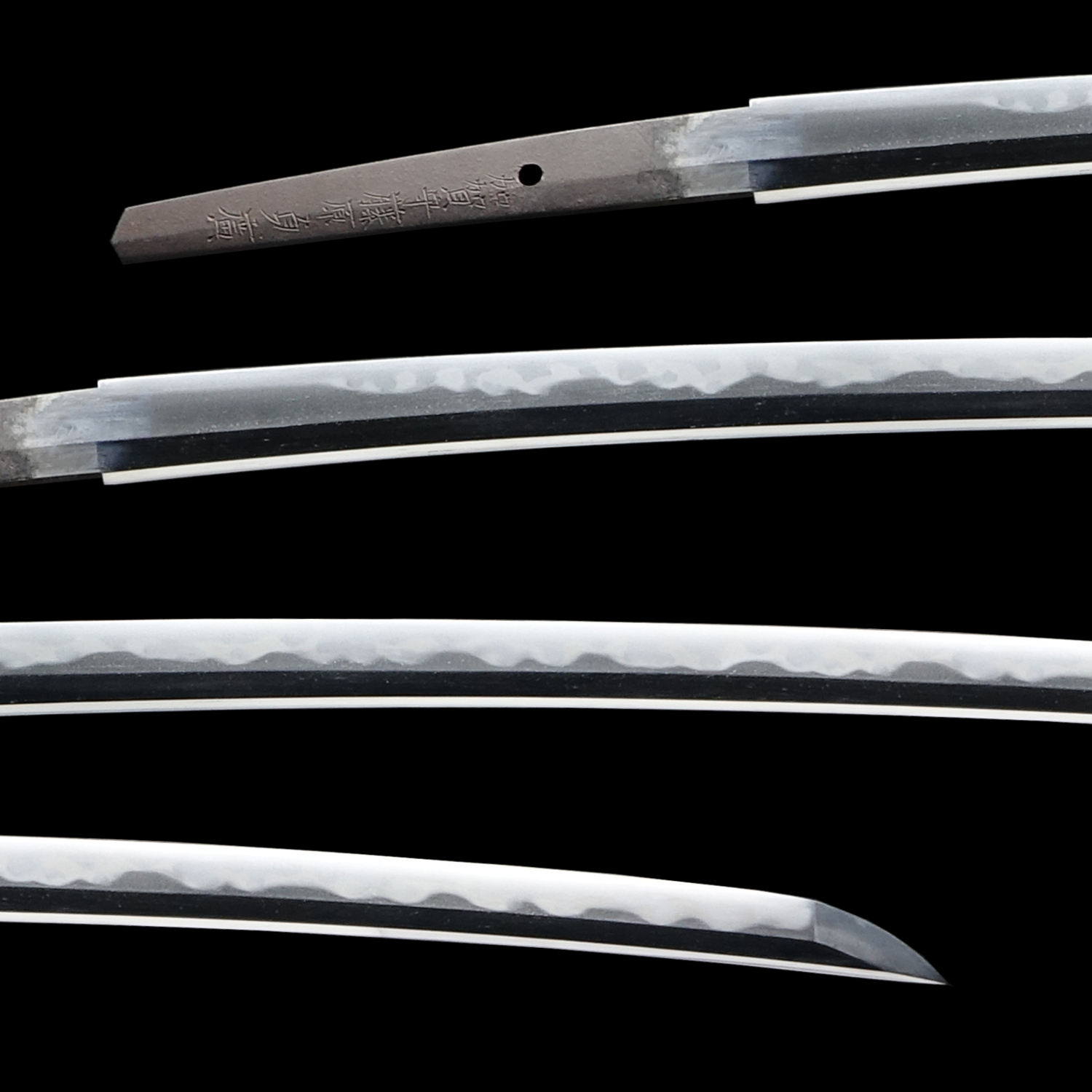
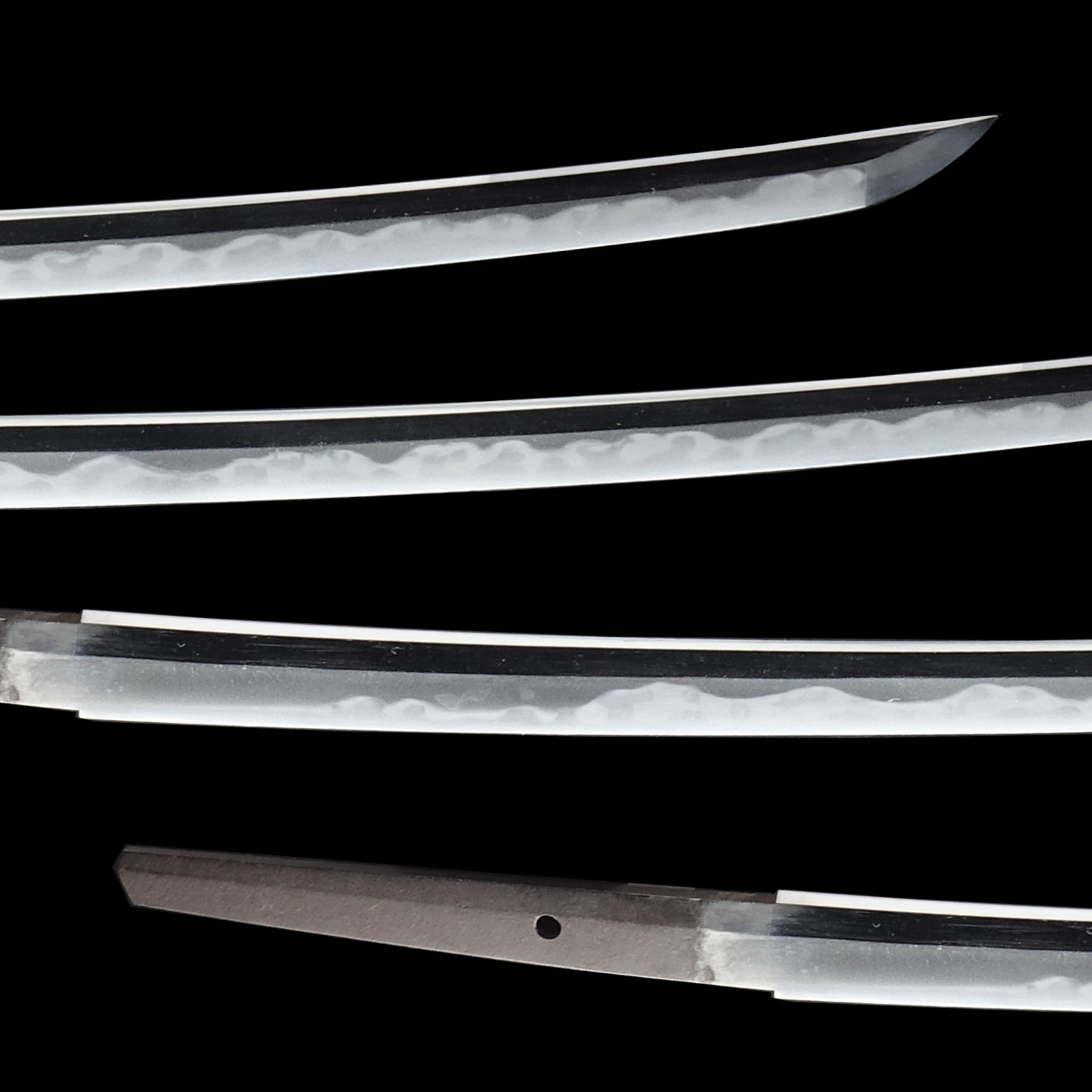
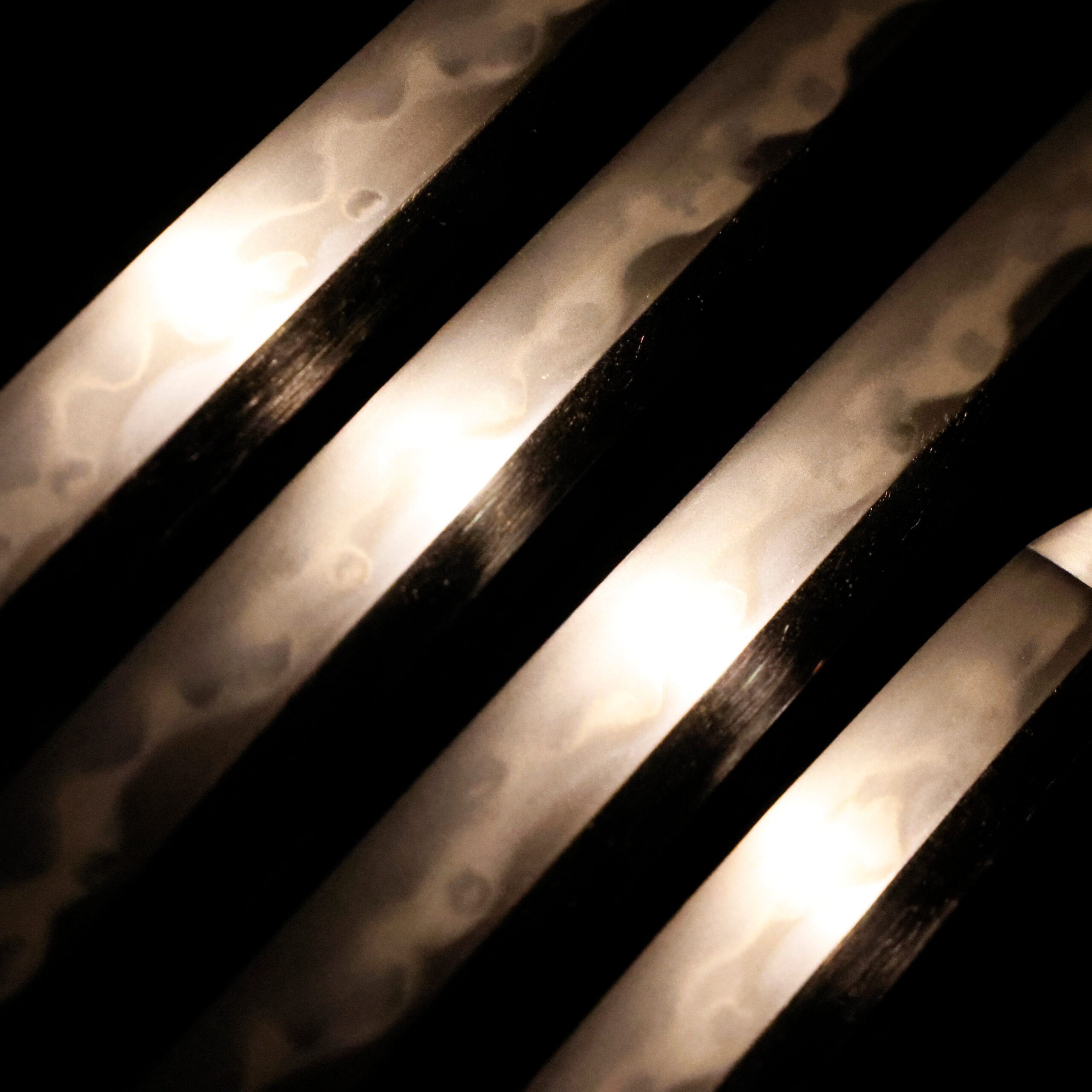
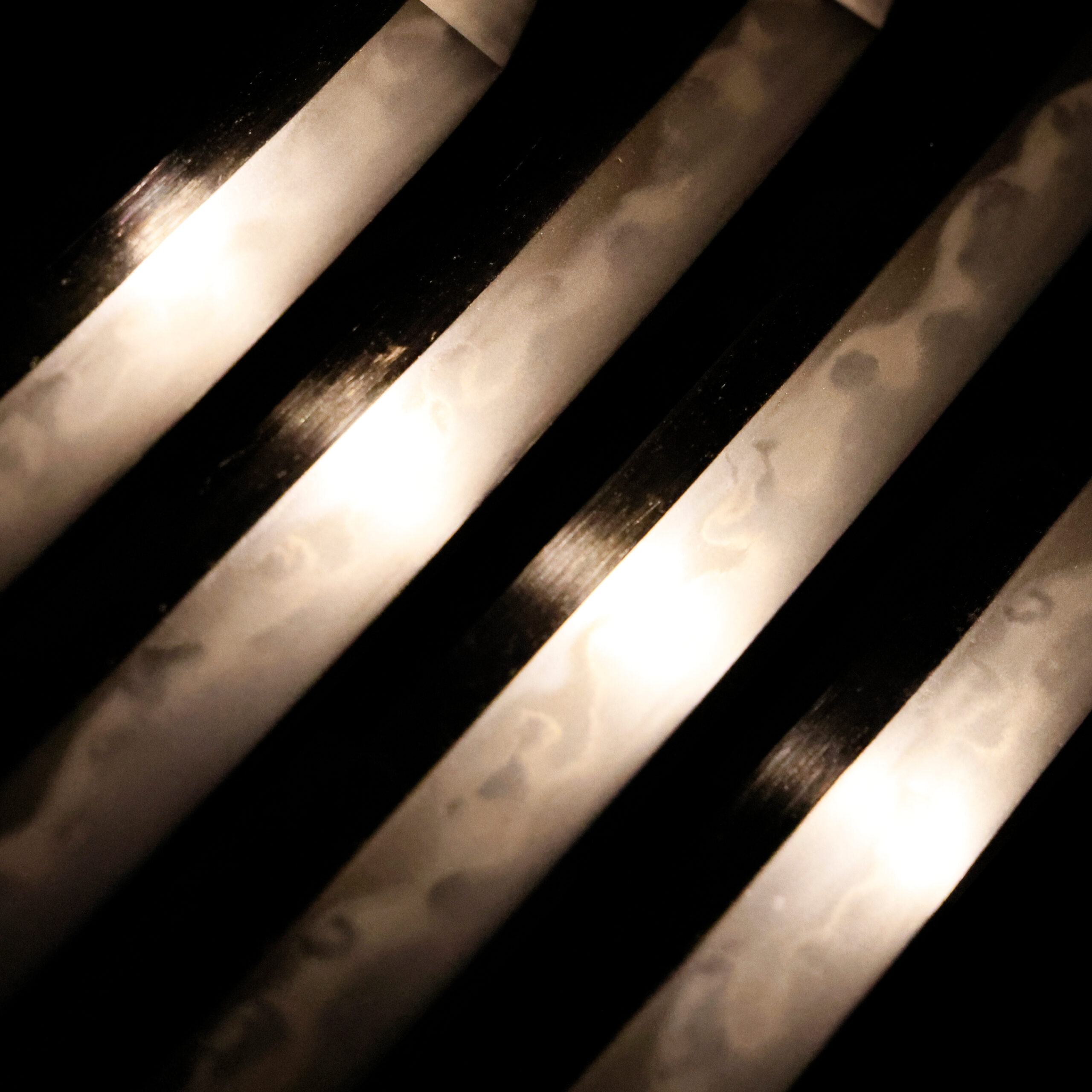
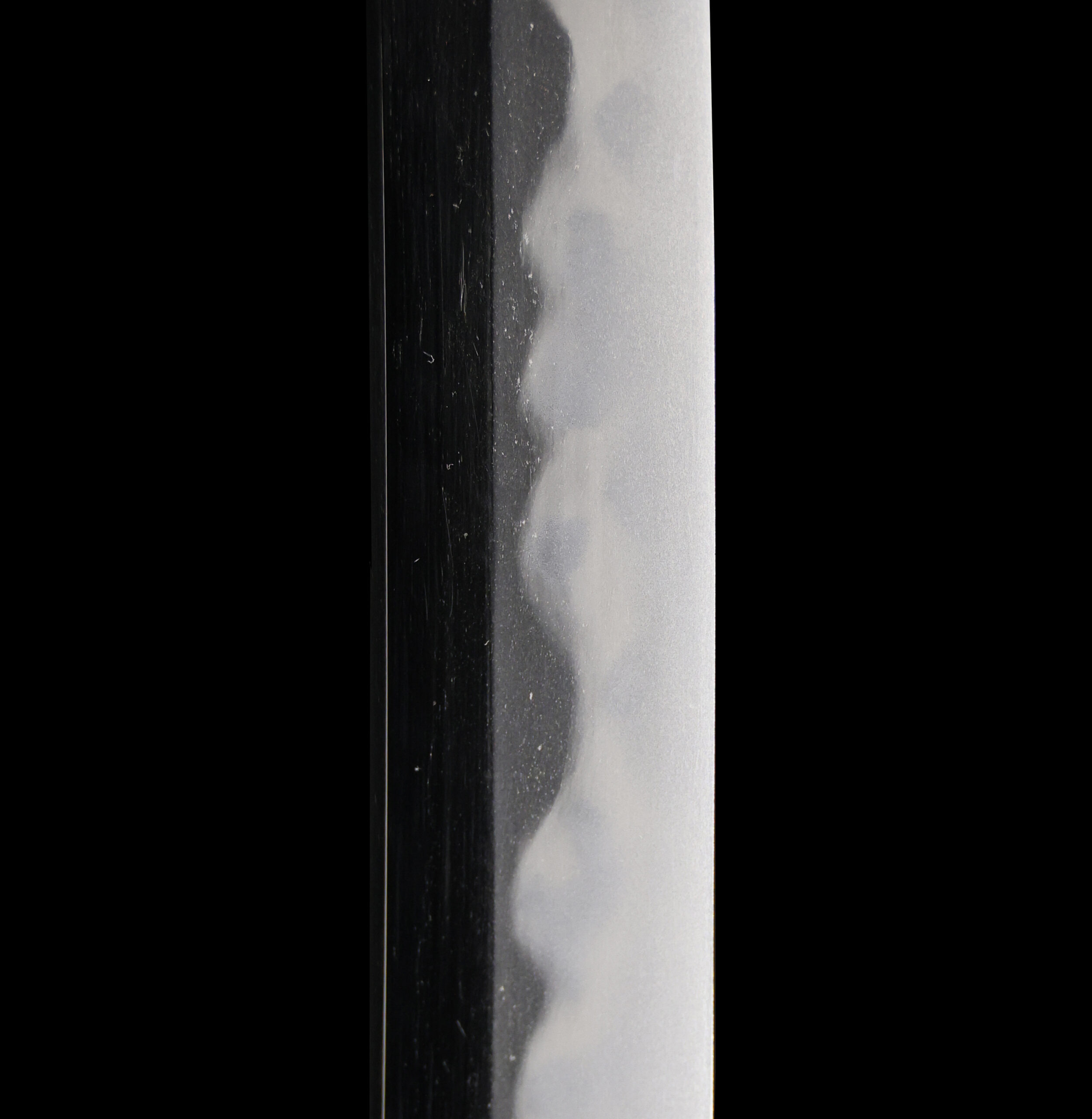
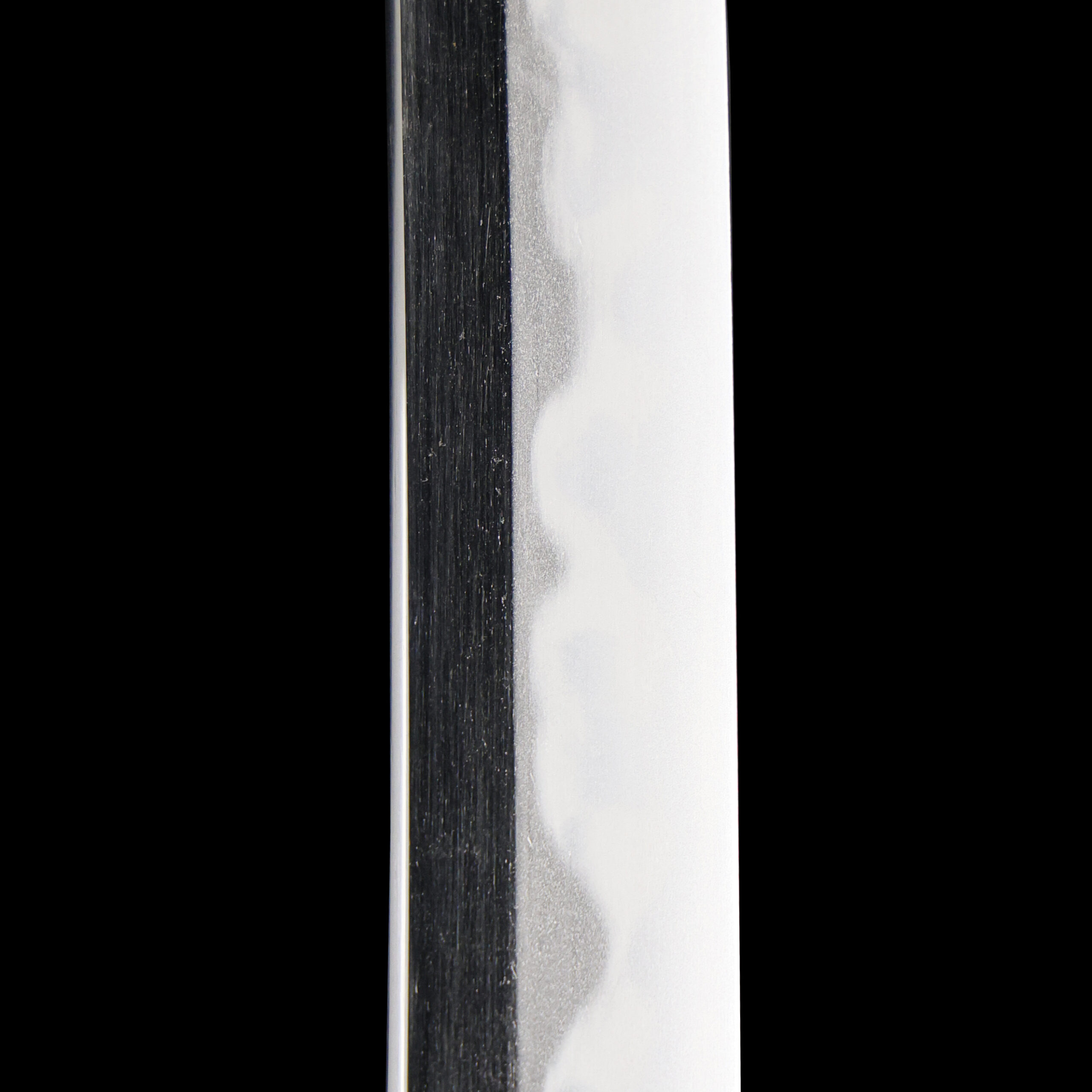
Kissaki:Kissaki is the tip of the Japanese sword.
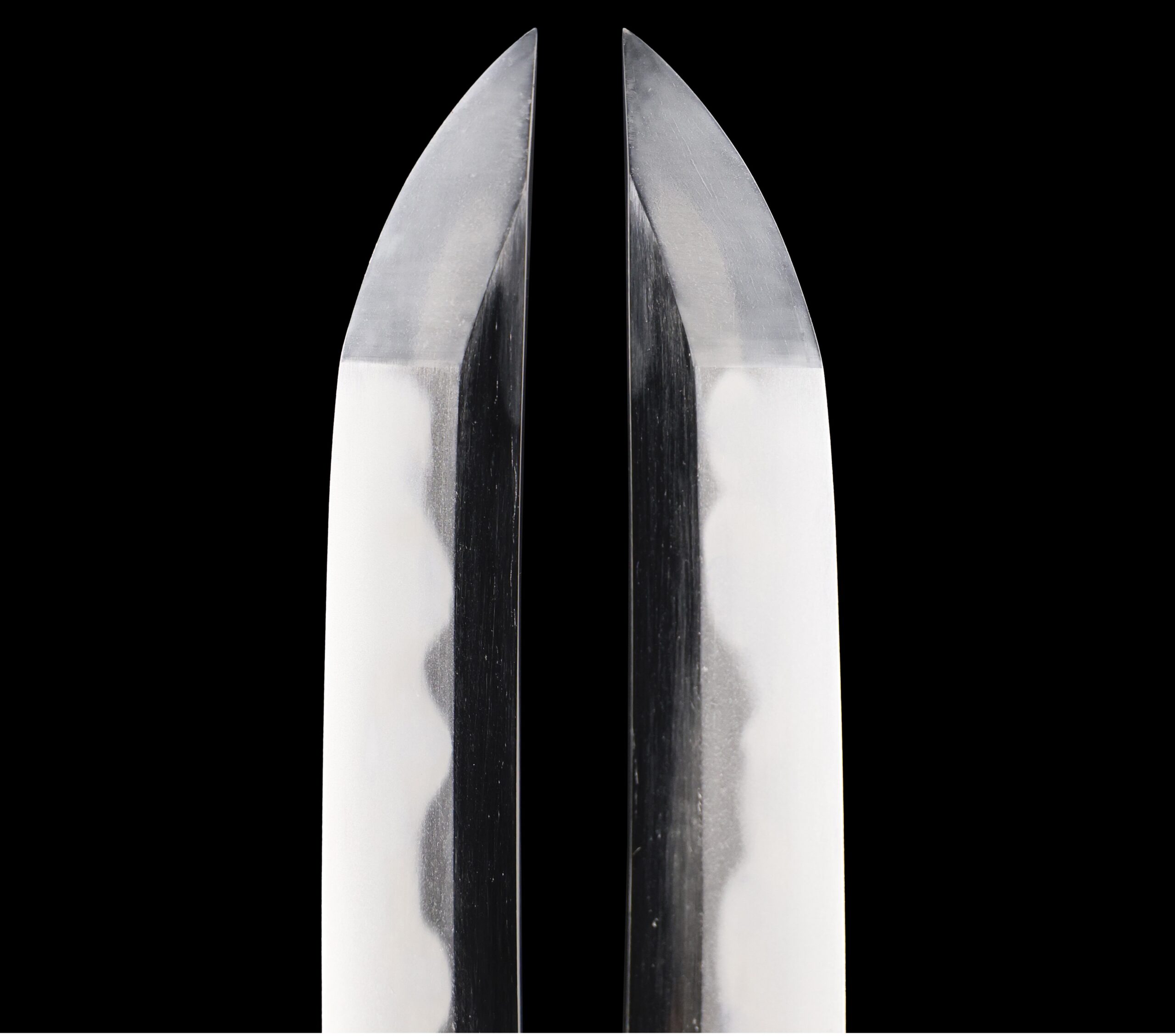
Nakago:Nakago is the tang of the Japanese sword.
Japanese swordsmiths left the black rust on the tang because it prevents red rust while the tang is in its handle. And the discoloration of the tang was created over time, and it is a great indicator for a Japanese sword specialist to estimate when the sword was forged.
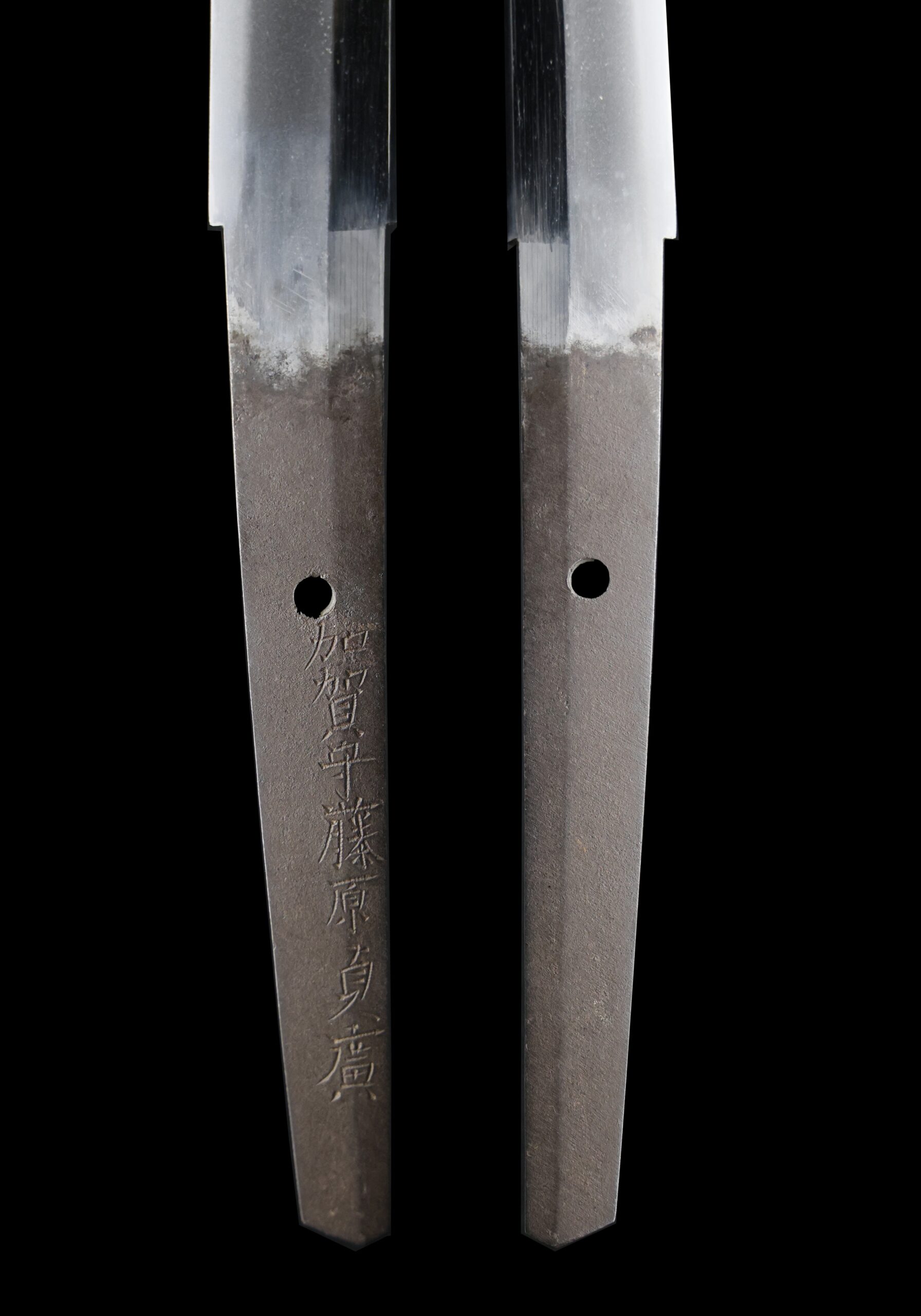
Koshirae:Koshirae is the mounting of the Japanese sword. There are several parts that consist of Koshirae such as Saya (Scabbard), Tsuka (Handle), Tsuba (Handguard).
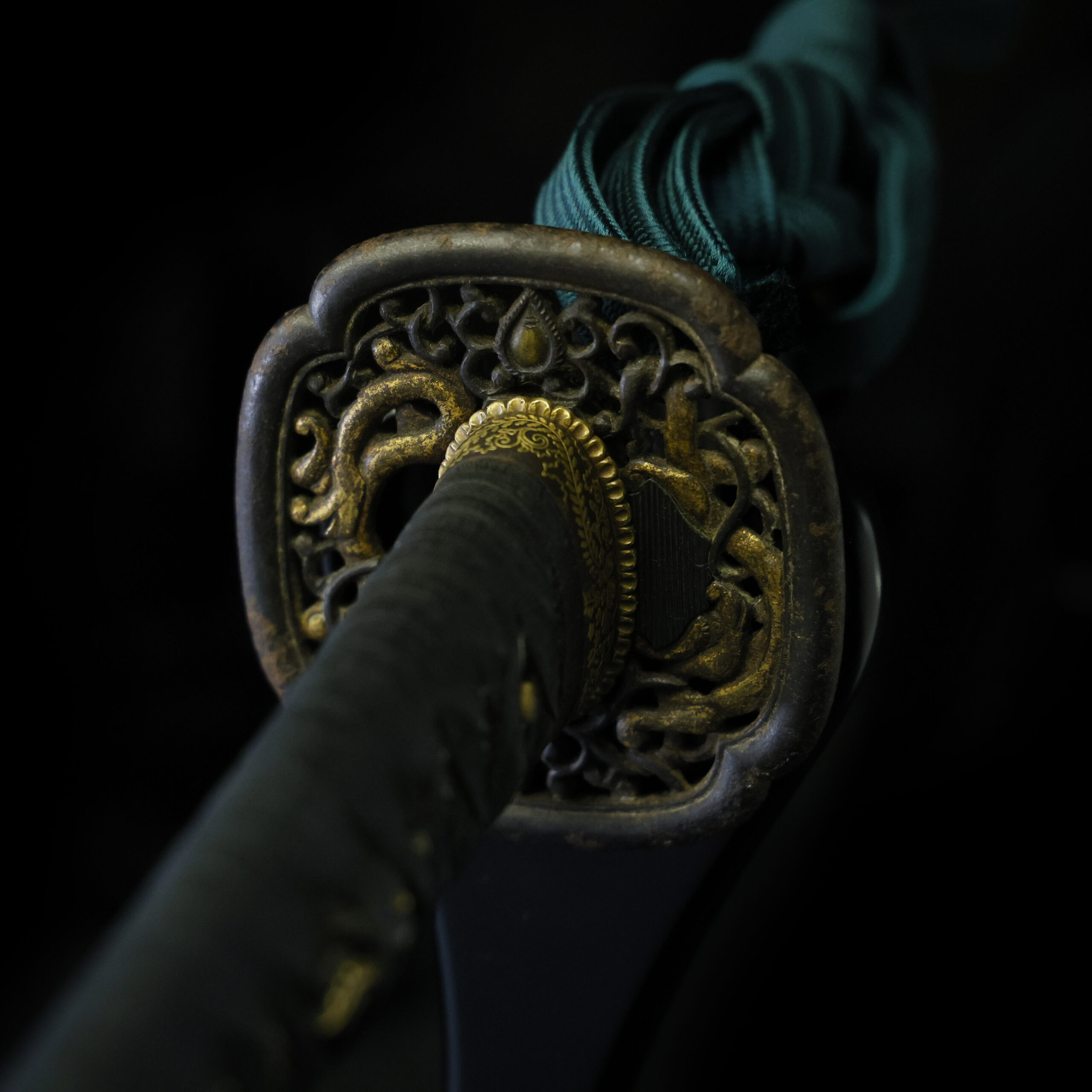
Fuchi-Kashira:A pair of matching sword fittings that cover the upper and bottom parts of its sword hilt.
This fuchi-kashira features a design based on the paulownia and arabesque vine motif (桐唐草, kiri-karakusa). This traditional pattern combines the kiri (paulownia tree)—a well-known symbol of good fortune in Japan—with karakusa (arabesque vines), which represent vitality and longevity. The karakusa design is inspired by the vigorous growth of creeping vines, whose endlessly extending tendrils have long symbolized eternal life, prosperity, and the continuation of family lines. In Chinese tradition, the vine’s trailing stems (man-dai, 蔓帯) are phonetically associated with the idea of “ten thousand generations,” further reinforcing its auspicious meaning. As a result, this motif has traditionally been favored in celebratory occasions such as wedding ceremonies and gift exchanges, symbolizing blessings for longevity and familial prosperity.
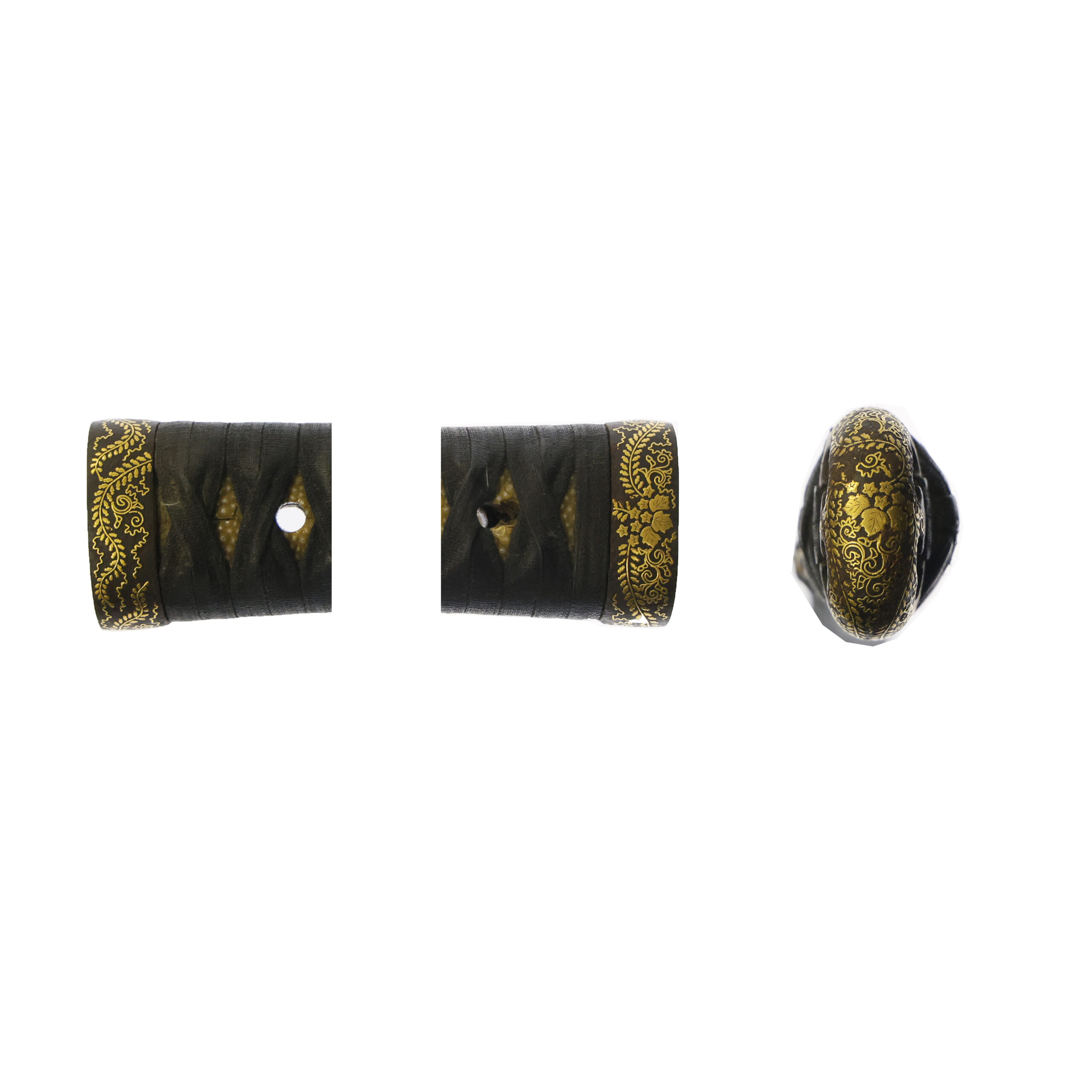
Tsuka and Menuki:Tsuka is the handle of the Japanese sword and Menuki is its decoration.
This menuki features a design of the phoenix (鳳凰, hō-ō) and paulownia tree (桐, kiri)—a pairing rooted in Chinese mythology and widely embraced in Japanese art and symbolism. The phoenix is said to have the front of a kirin (麒麟, a mythical beast), the rear of a deer, and dazzling feathers in five colors: black, white, red, blue, and yellow. Known as the king of birds, it is believed that when the phoenix takes flight, all other birds follow in its wake.
The origin of the “phoenix and paulownia” motif (桐鳳凰図, kiri-hōō zu) lies in the ancient belief that the phoenix nests exclusively in paulownia trees, where it brings peace, prosperity, and good fortune. This auspicious pairing became a popular decorative theme, particularly during the Edo period, and was often used in family crests and ornamental sword fittings to symbolize household prosperity, harmony, and abundance.
This Tsuka features a style of cord wrapping known as itohira-maki, in which the width of the cord is kept consistent and the overlapping sections are finished flat rather than raised. This technique results in a smooth and even appearance. It is often used in traditional sword mountings known as itomaki-tachi koshirae—a type of ornate tachi-style mounting—and is therefore also commonly referred to as “tachi-maki”. The refined flat wrapping not only enhances the aesthetic but also reflects the formal elegance associated with ceremonial swords.
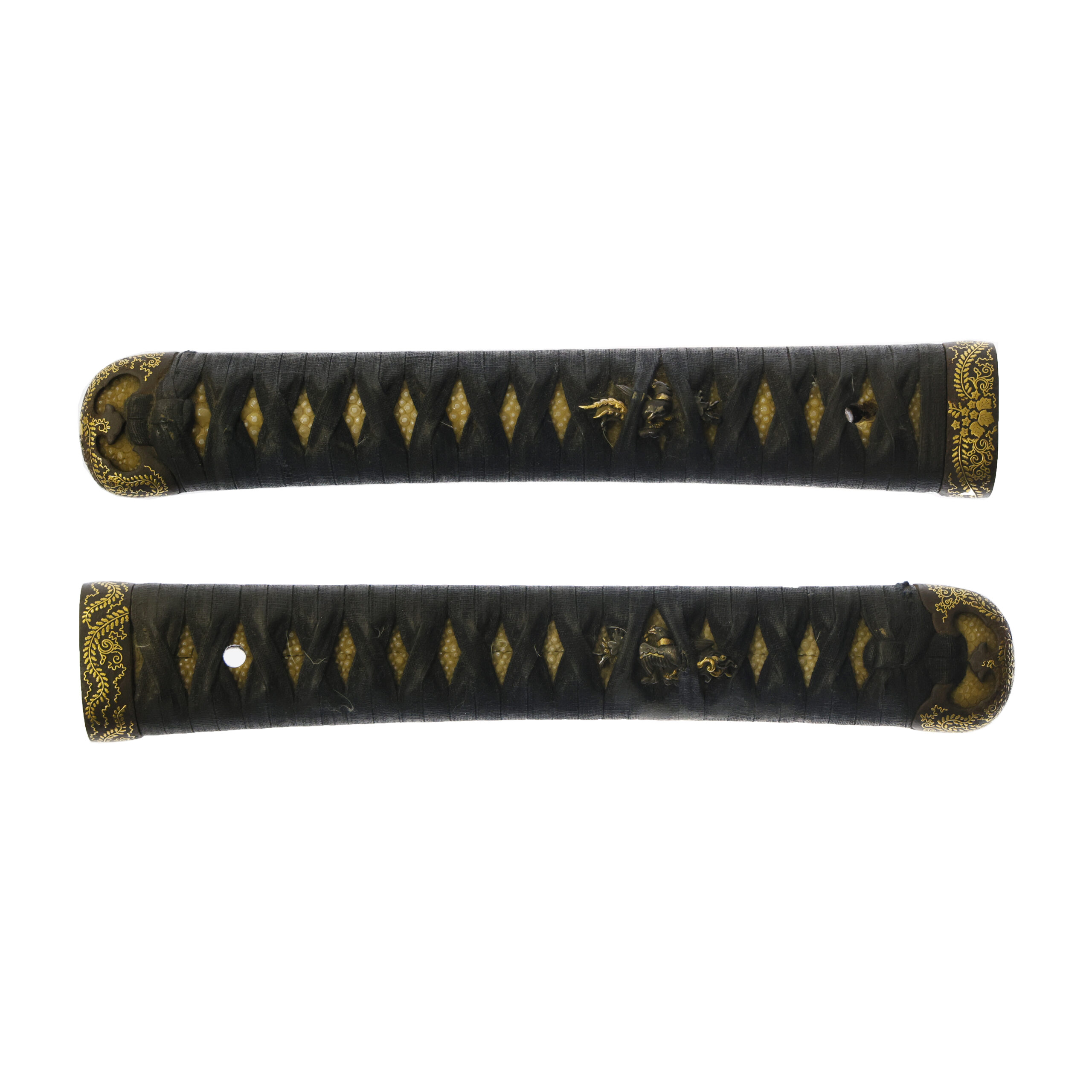

Tsuba and Habaki:Tsuba is the handguard for the Japanese Sword and Habaki is the equipment to make the blade not touch its scabbard inside. It prevents the blade from getting rusty and chipped.
This tsuba is a Nanban tsuba featuring a motif of twin dragons and arabesque vines (karakusa). Nanban tsuba refers to sword guards influenced by European decorative styles that became popular in mid-Edo period Japan, incorporating exotic designs known collectively as Nanban (meaning “Southern Barbarian” or “foreign”). The dragon, a mythical creature considered one of the most auspicious symbols in East Asian culture, is often associated with power, wisdom, and good fortune. Combined with the flowing karakusa (arabesque vine) pattern, which represents eternal growth and prosperity, this design embodies a powerful wish for protection, longevity, and good luck.
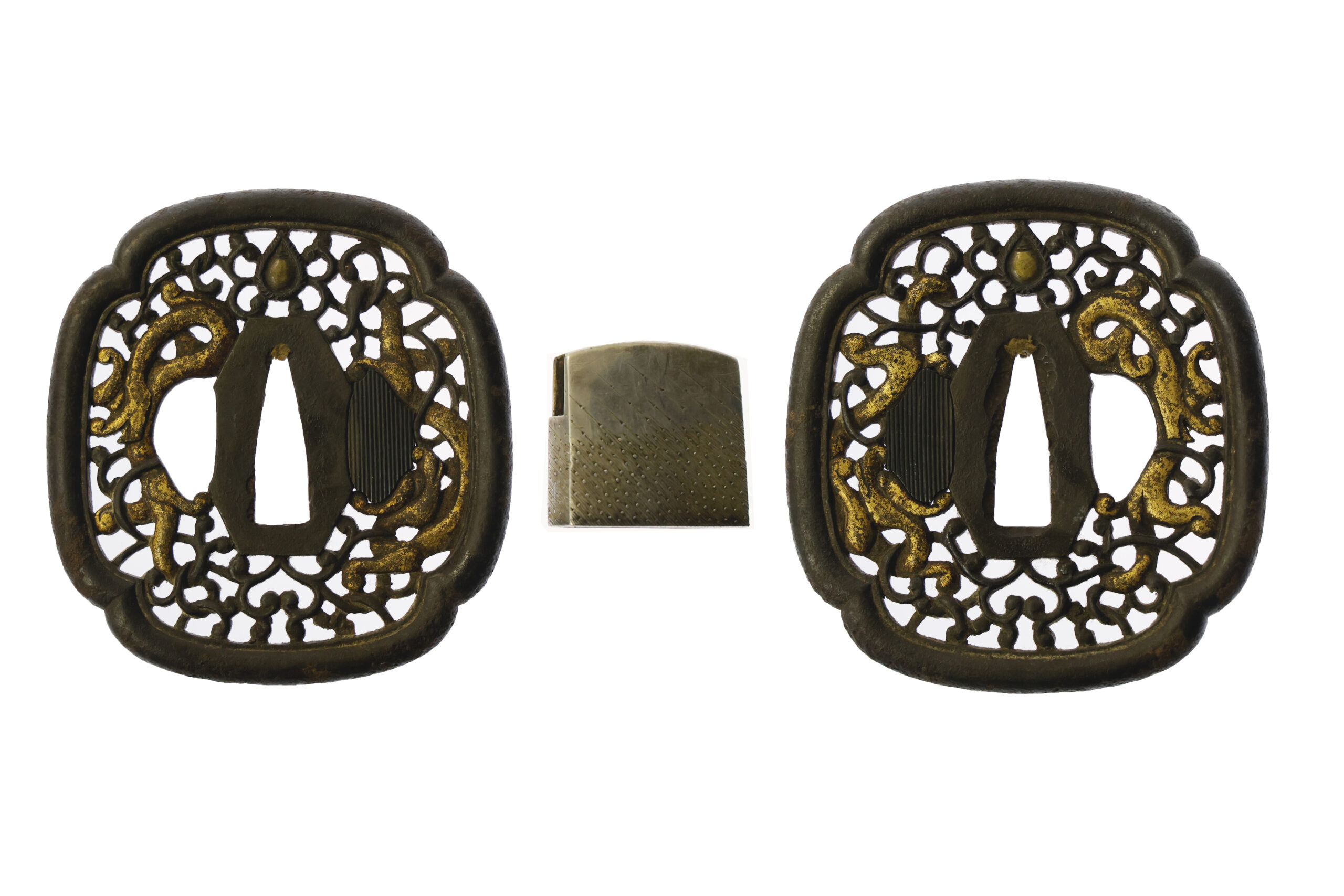
Saya:Saya is the scabbard for the Japanese sword.
This type of Saya is called Kuro Ishime Nuri Kizamizaya (黒石目塗刻鞘).
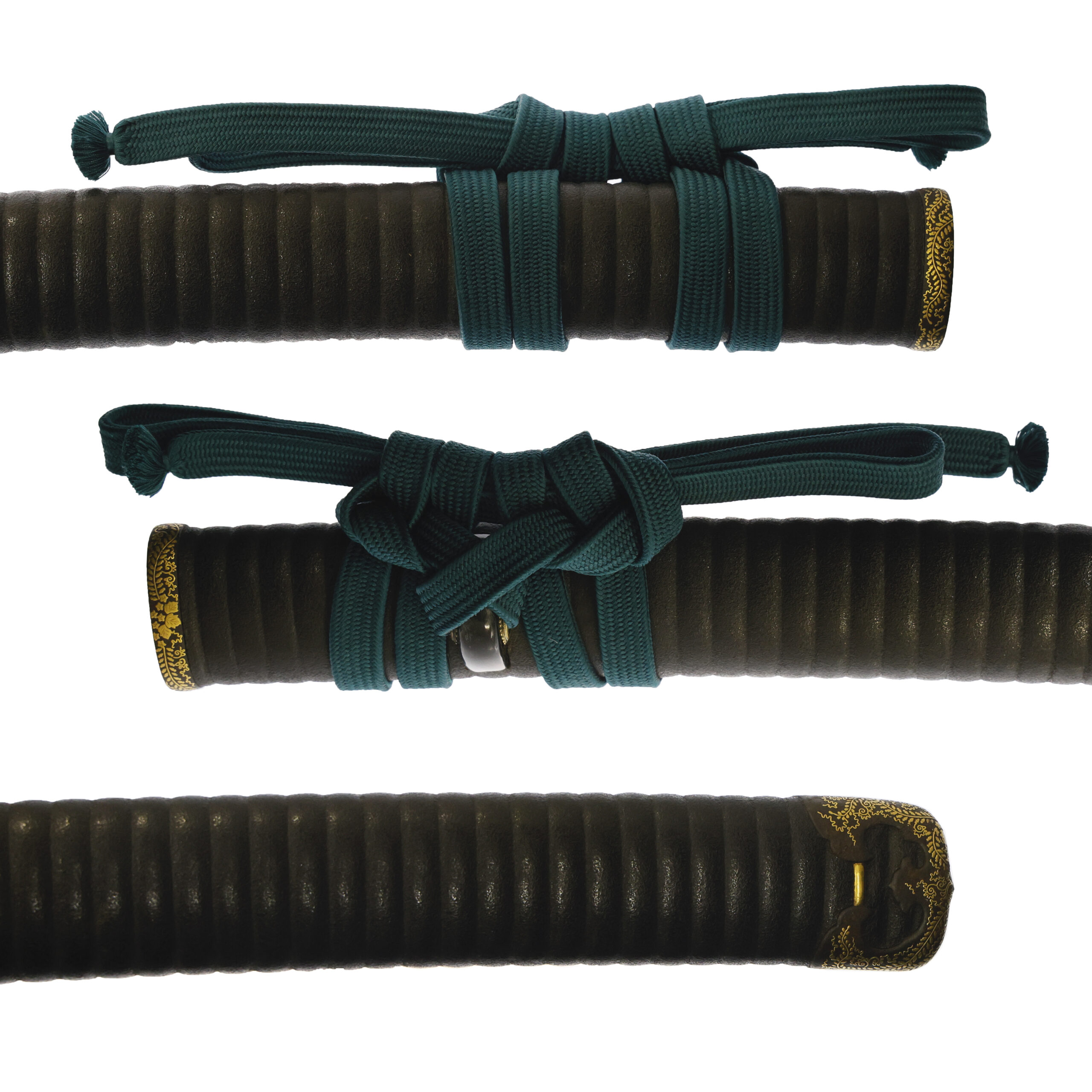
Authentication Paper:NBTHK TOKUBETSU Hozon Certificate for the blade (No. 1021706)
NBTHK, also known as Nihon Bijutsu Touken Hozon Kyokai (the Society for the Preservation of the Japan Art Sword), is one of the oldest Japanese sword appraising organizations in modern-day Japan. They authenticated the blade on December 15th in the 5th year of Reiwa (2023). They appraised it as Tokubetsu Hozon Touken, the blade especially worth preserving for Japanese society. The purchaser will receive this original certificate as well. We can also translate what is written into English and make a PDF file for your record if you request.
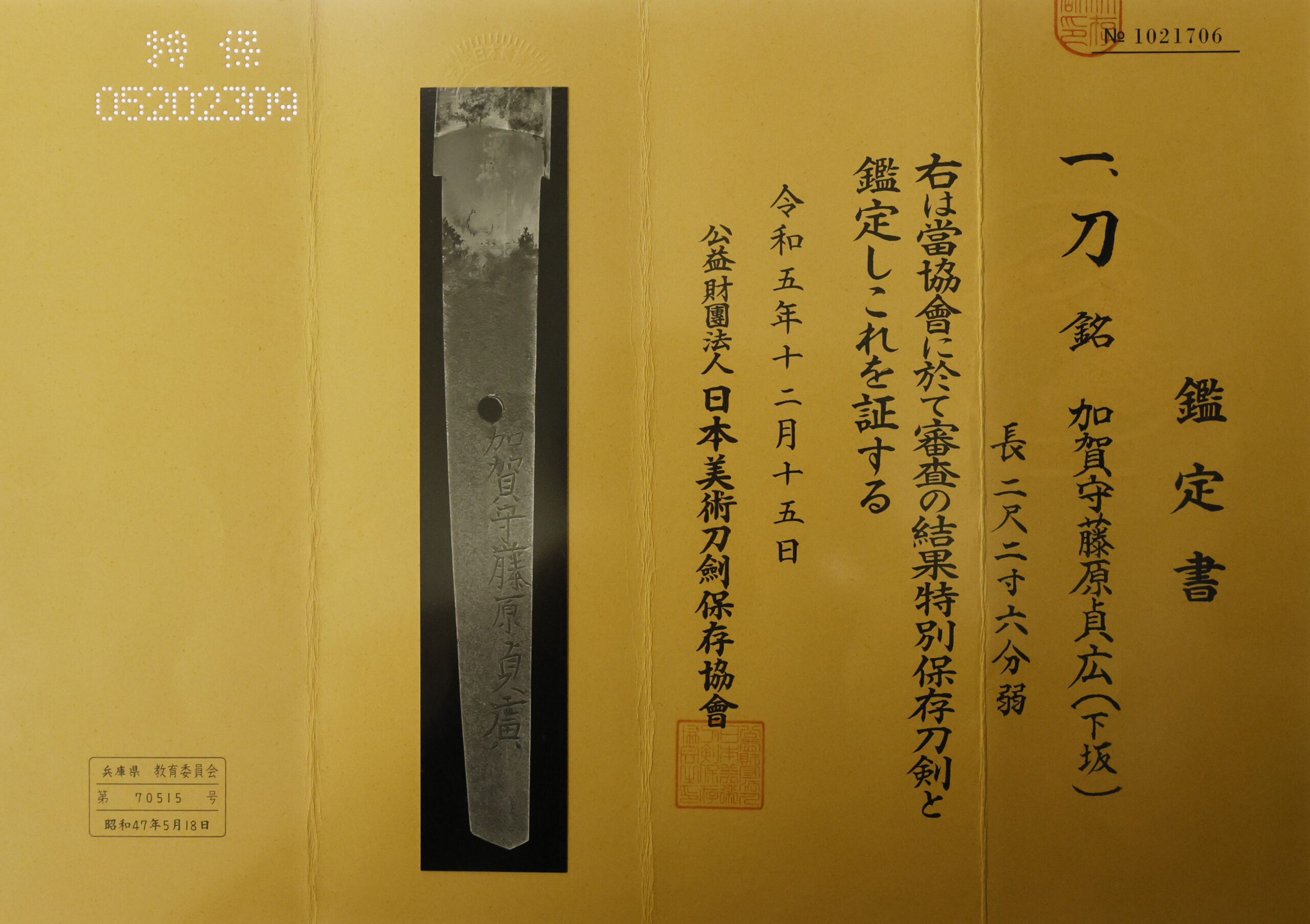
Authentication Paper:NBTHK TOKUBETSU Hozon Certificate for the Koshirae (No. 2011061)
NBTHK, also known as Nihon Bijutsu Touken Hozon Kyokai (the Society for the Preservation of the Japan Art Sword), is one of the oldest Japanese sword appraising organizations in modern-day Japan. They authenticated the Koshirae on September 26th in the 6th year of Reiwa (2024). They appraised it as Tokubetsu Hozon Tosougu, the sword mounting especially worth preserving for Japanese society. The purchaser will receive this original certificate as well. We can also translate what is written into English and make a PDF file for your record if you request.
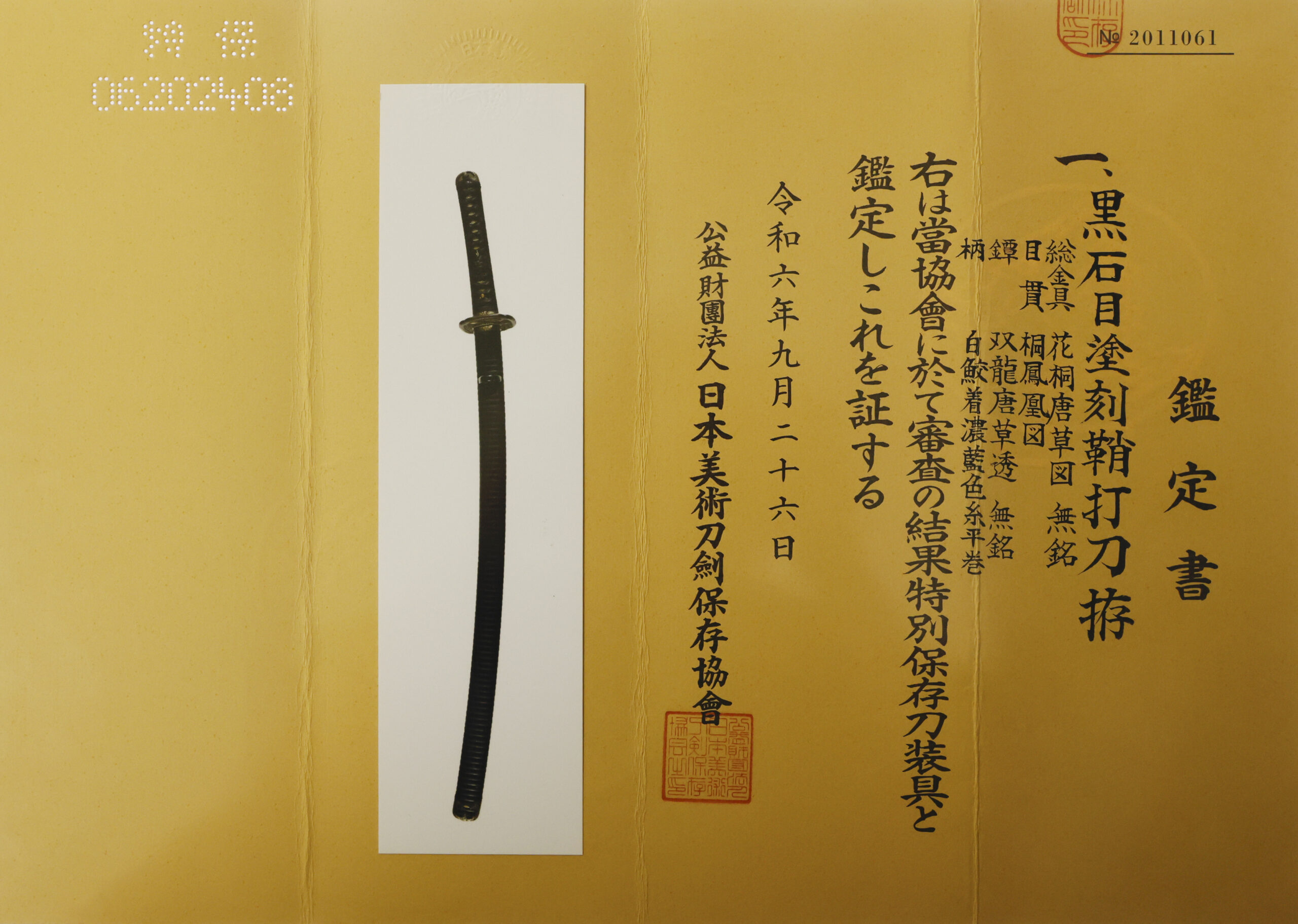
Registration Number : Hyogo 70515
The Board of Education in Hyogo prefecture issued a registration paper for this sword. It is called Jyu Hou Token Rui Tourokusho (銃砲刀剣類登録証). Bunkacho (The Agency for Cultural Affairs) acknowledges a Japanese sword with this paper as a work of art.
The sword needs to be traditionally hand-forged and made of Tamahagane carbon steel to be registered in the system. With this paper, its owner in Japan can legally own an authentic Japanese sword. Based on this registration number, we will apply for its export permit.
This paper will need to be returned to the board of education when the sword is being shipped abroad, but you can receive a copy of it. An English translation of this registration paper is available on request.
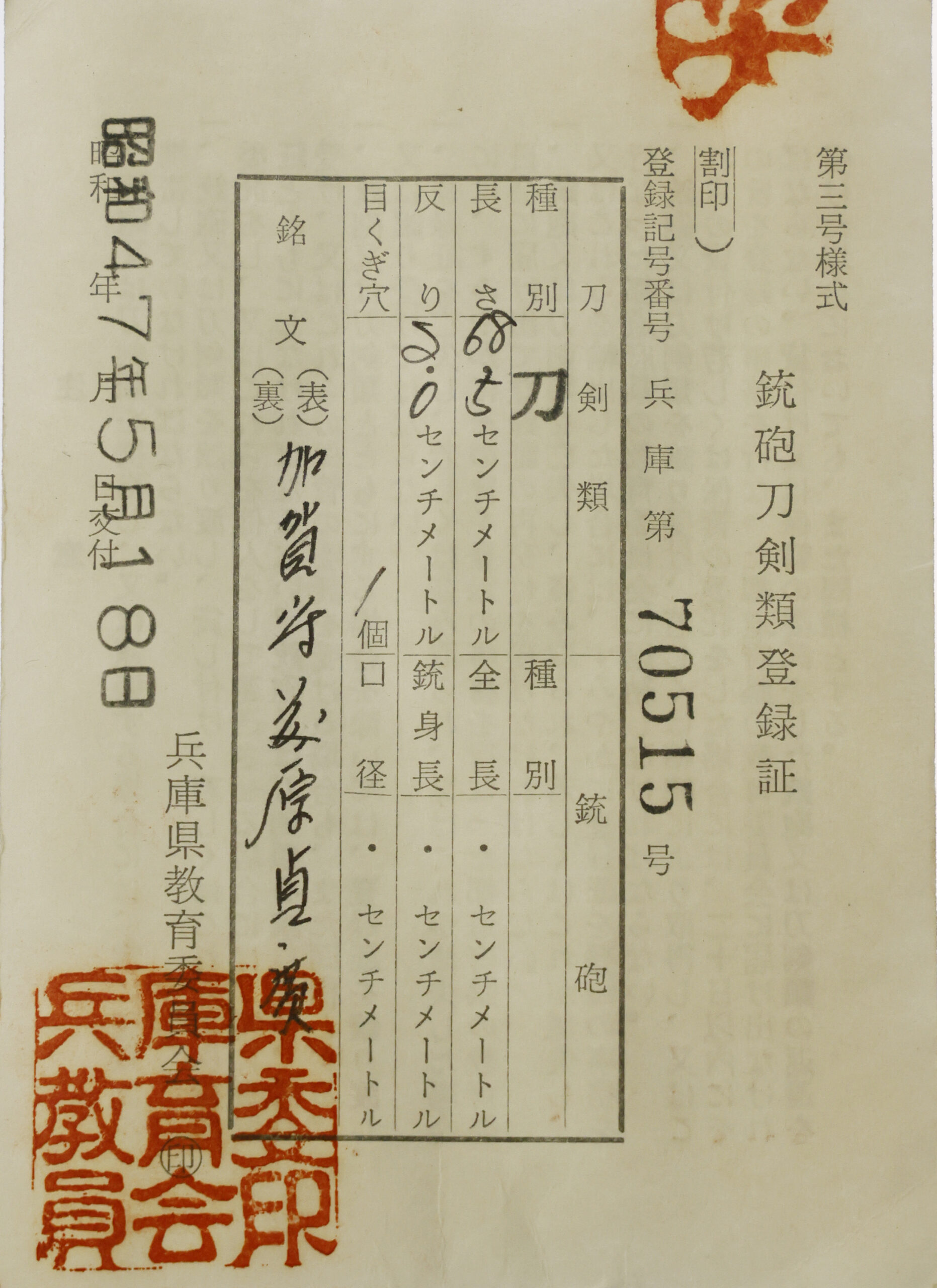
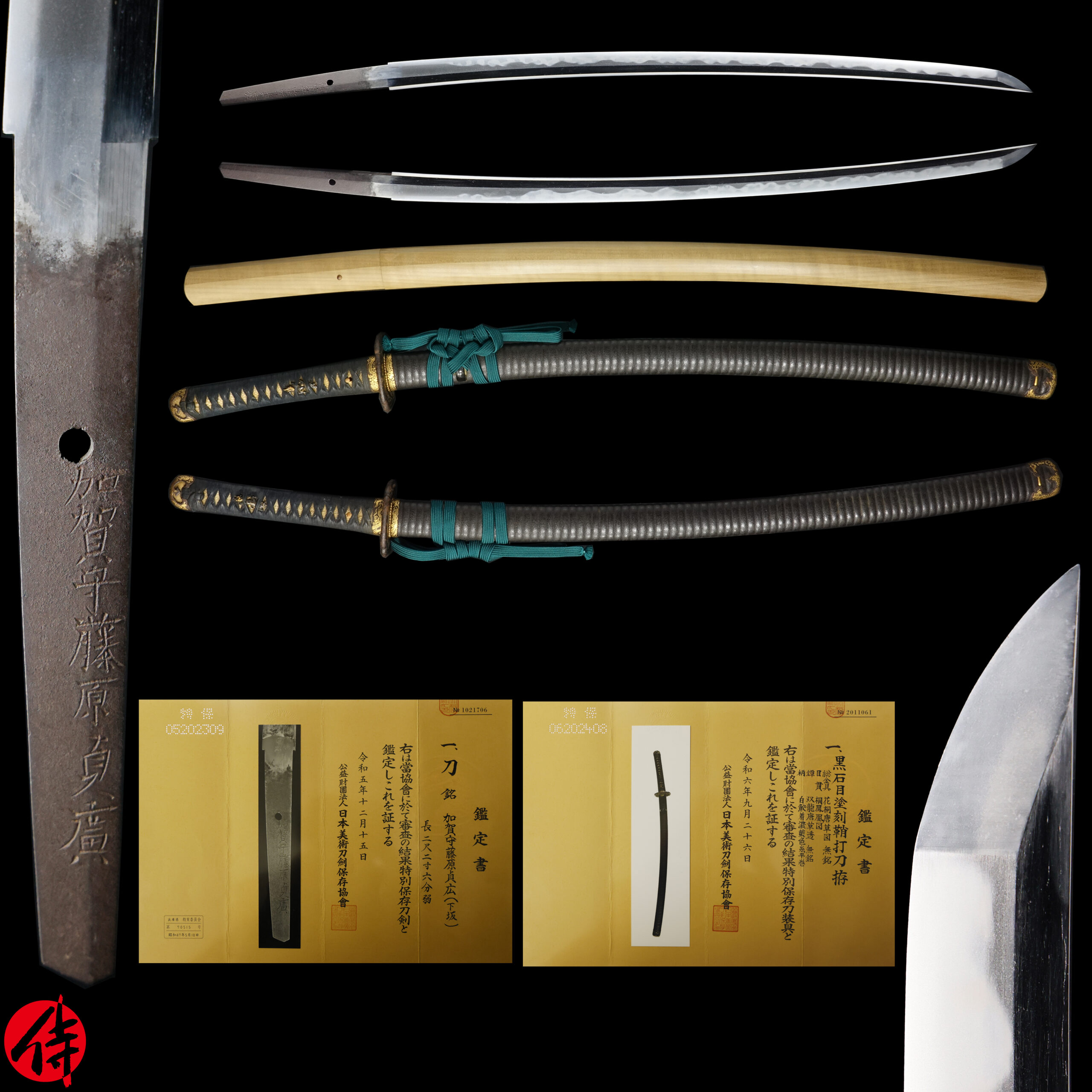
—————————————————————–
【About us】
Samurai Museum is located in Tokyo, Japan, exhibiting antique artifacts related to the Samurai history. Samurai Museum Shop is the place for those who are interested in Japanese culture and craftsmanship. We deal with antique Samurai swords/armor, traditional crafts made in Japan and so on.
【Japanese Sword& Export Process】
The Japanese swords we deal with are hand-forged edged swords made in Japan. It was made from the traditional carbon steel called TAMAHAGANE(玉鋼). Samurai Museum is familiar with the proper legal procedure for an antique/ authentic Japanese sword to be exported from Japan. We have sent more than 1000 Japanese swords for the past few years (~2025) to amazing owners who appreciate its historical value.
Each Japanese sword is registered under the Agency for Cultural Affairs and the Board of Education in Japan. They issue a registration paper for each Japanese sword for its owner in Japan to legally possess it. The Japanese sword with its registration paper means it was traditionally hand-forged in Japan.
To legally export the sword from Japan to other countries, we will have to apply for its permit to the Agency for Cultural Affairs(Bunkacho) and return the original registration paper to the Board of Education. It normally takes around 2-4 weeks to receive this permit after submitting required documents. And we would like you to expect at least 1-1.5 months for your order to arrive at your given address after you ordered. For more detailed info, please click here.
It is allowed for residents in Japan to own authentic Japanese swords without a special license as long as they come with registration papers. Please feel free to contact us if you are a resident of Japan, whether temporarily or permanently. We will also assist you when you leave Japan and need to obtain the export permit.
【Payment Method】
We accept payment through Stripe (Credit card), PayPal, Apple Pay or ChromePay, all of which are secure payment methods. Also, you don’t need to make an account on Stripe for the checkout. If you prefer other payment method, please contact us. After confirming your payment, we will apply for an export permit. You may either pay in JPY, USD, AUD, CAD,EUR CHF or GBP. The price is set in Japanese Yen. Prices in other currencies are automatically calculated based on the latest exchange rate.

* If the amount is above 1 million JPY, Stripe or wire transfer will be the only options for payment.
【Shipping】
We have shipped authentic Japanese swords to the USA, Canada, Mexico, Germany , Belgium, France, Finland, UK, Hong Kong, Australia. If you don’t live in these countries and like to order, please contact us first before making a purchase. We offer Free International Shipping as long as we can send antique Japanese swords by EMS.
We normally ship by EMS(Express Mail Service) provided by Japan Post. We will send you a tracking number for your order as soon as we hand it to the post office. We will put 100 % insurance on the shipping document without any extra charge. Based on the total amount, there might be a duty tax or other fee for you to pay, depending on the countries. We use package cushioning to protect the item and put it in a PVC pipe, which is one of the most secure packages because of its durability.
It will normally takes 5-14 days for the item to arrive at your given address after we dispatch it. Time of delivery is estimated as accurately as possible by the carrier but does not take into account any delays beyond our control such as by inclement weather, post office holiday seasons.
* If you live in Australia and like to purchase an authentic Japanese sword, please click here to know the detail.
* If you live in the UK and like to purchase an authentic Japanese sword, please contact us first and click here to know the detail.

【Review】
Here is one of the reviews we received from a customer who purchased an authentic Japanese sword from us. For more reviews, please click here.
“My experience overall with the whole process was wonderful. I had many questions about the history and process to purchase these treasures. All my questions were answered very timely and complete. The staff is very knowledgeable and very well versed if any questions do arise.”
【How to make sure the condition】
Please keep in mind that what you are going to purchase is an antique item. We uploaded high resolution photos for you to check its condition thoroughly. If you like to see more photos with different angles, please feel free to contact us. We will be happy to send them to you so that you can make informed decision. It is essential for us to know that you are happy with your choice of a sword. and we are prepared to use the best of our ability to serve you.
【How To Contact Us】
Please contact us through email, Facebook Messenger or Live Chat if you have any questions. You can find each icon on the right side of the website. Please click one of them to reach us. We will reply to you within 1-2 business days.
【The Art of Nihonto (Japanese Sword)】
Samurai’s history is a profound, eloquent legacy of ancient Japanese warriors in which millions of people worldwide are being fascinated. If you like to find out the art of Nihonto, please click here.
【A Guide to Japanese Sword Maintenance】
After acquiring an genuine Japanese sword, it is also important to know how to take good care of it. Here is the special video for you. Mr. Paul Martin, Japanese sword expert, shows you how to give proper maintenance to your sword. By mastering how to clean the Japanese sword, its aesthetic beauty will last forever.
When you purchase a Japanese sword from us, you can get a Free Japanese sword maintenance kit. It comes with four tools(Choji Oil, Uchiko Whetstone Powder, Peg remover, Oil Applicator). By watching the video instruction above , you can enjoy learning how to maintain your Japanese sword while appreciating it. If you have any difficulty assembling the sword or cleaning the blade, you can feel free to contact us.
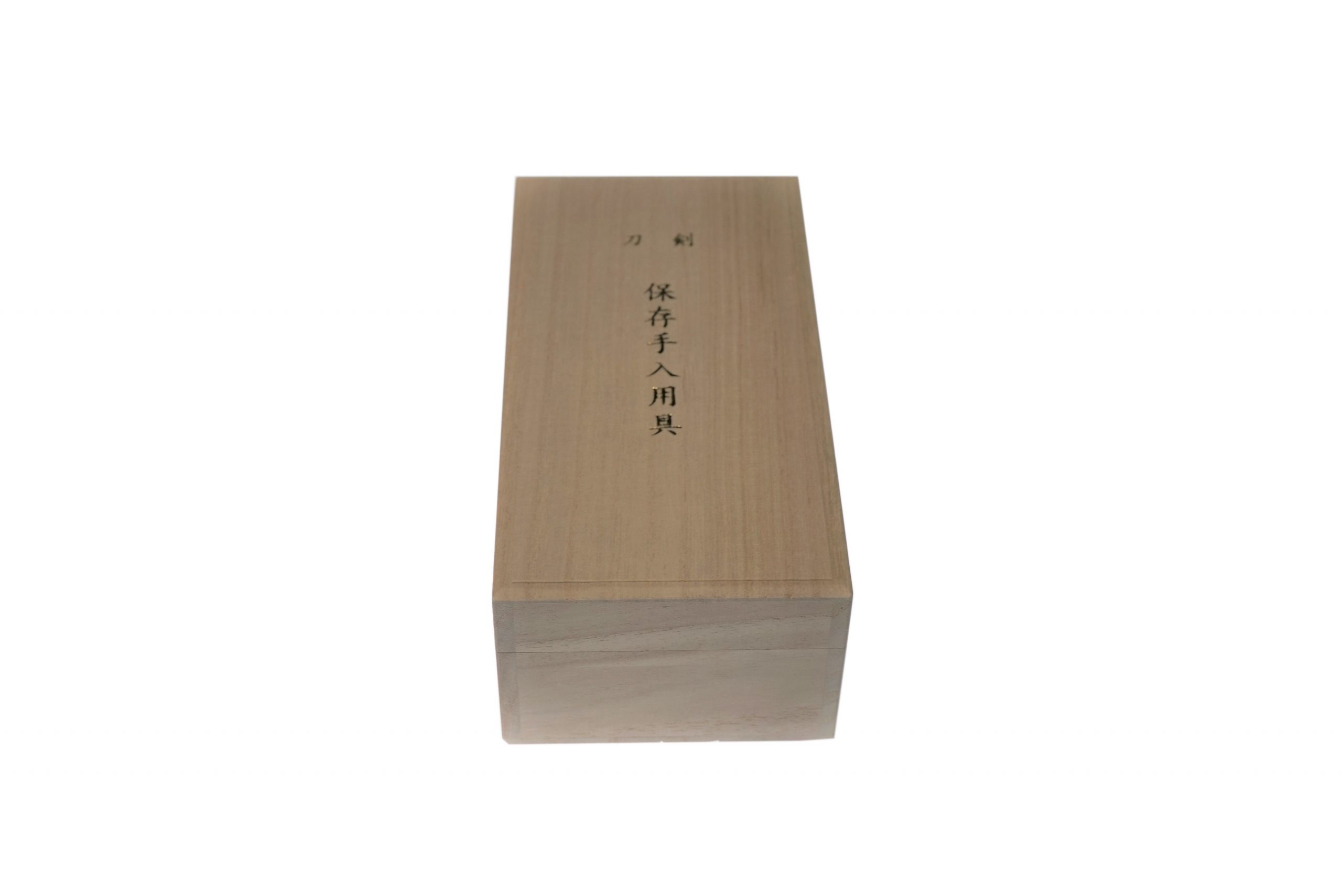
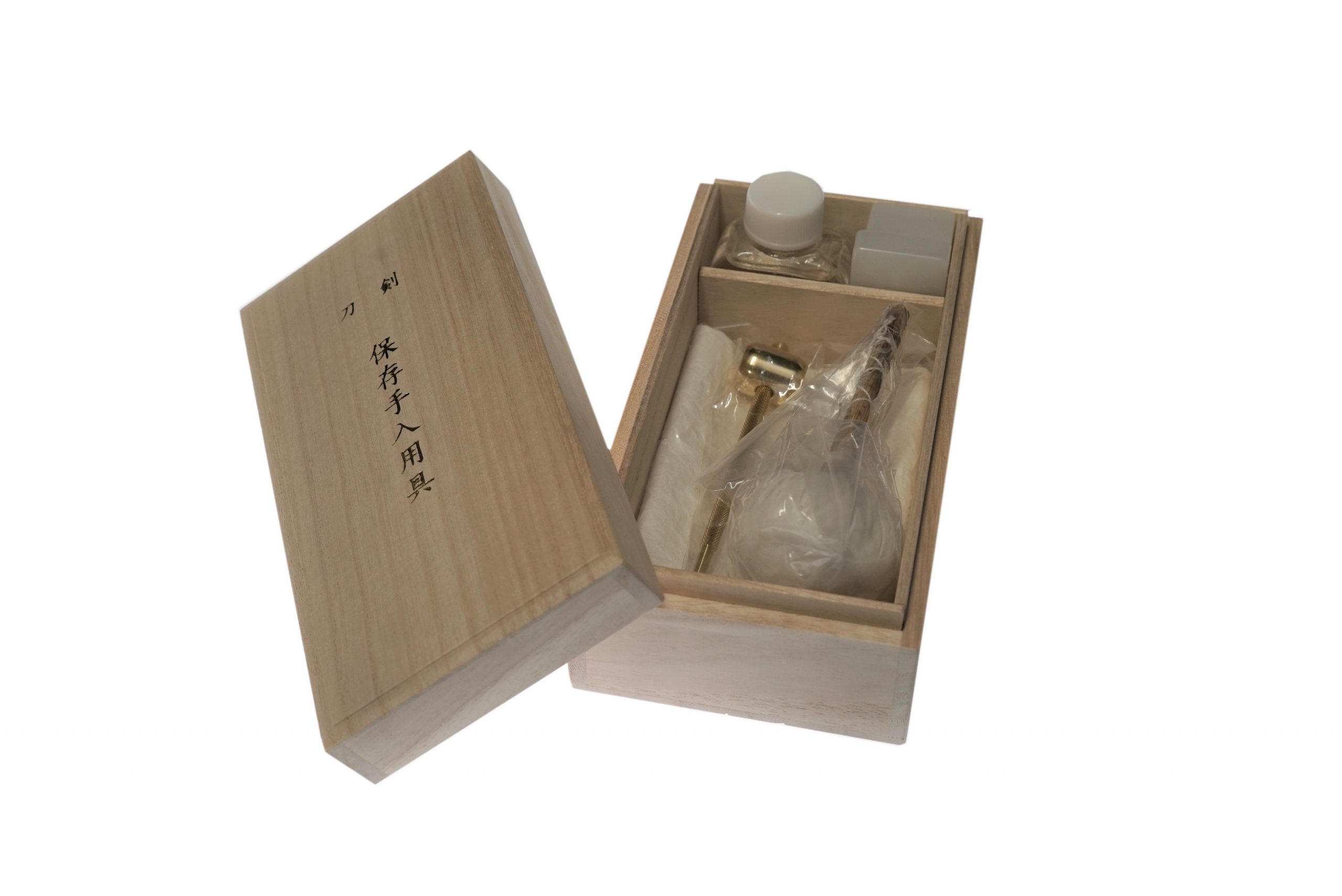
MORE ANTIQUE JAPANESE SWORD FOR SALE
SWORDS WITHOUT CERTIFICATES FOR SALE
LEARN JAPANESE SWORD TERMINOLOGY
Thank you for reading all the information on the page. If you have any difficulty choosing the right Japanese sword for you, we will be more than happy to help you find the one that speaks to you the most. Please feel free to contact us.

